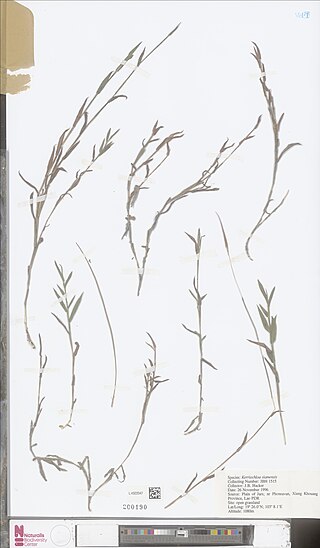
Joseph Marie Henry Alfred Perrier de la Bâthie was a French botanist who specialized in the plants of Madagascar.

Soejatmia is a monotypic genus of flowering plants belonging to the family Poaceae. It just contains one species, Soejatmia ridleyi(Gamble) K.M.Wong

Carl Christian Mez was a German botanist and university professor. He is denoted by the author abbreviation Mez when citing a botanical name.

Kerriodoxa elegans, the white backed palm, is the only species of palm tree in the genus Kerriodoxa, in the family Arecaceae.

Kerriochloa is a genus of Southeast Asian plants in the grass family. The only known species is Kerriochloa siamensis, native to Thailand and Vietnam.
Arthur Francis George Kerr (1877–1942) was an Irish medical doctor. He is known particularly now for his botanical work, which was important for the study of the flora of Thailand.
Tribounia is a genus of flowering plants belonging to the family Gesneriaceae.
Thepparatia is a monotypic genus of flowering plants belonging to the family Malvaceae. It only contains one known species, the liana Thepparatia scandens.
Thawatchaia is a genus of flowering plants belonging to the family Podostemaceae.
Hanseniella is a genus of flowering plants belonging to the family Podostemaceae.
Kaisupeea is a genus of flowering plants belonging to the family Gesneriaceae.
Maasia is a genus of flowering plants belonging to the family Annonaceae.
Marcania is a monotypic genus of flowering plants belonging to the family Acanthaceae. It only contains one known species, Marcania grandifloraJ.B.Imlay

Nayariophyton is a monotypic genus of flowering plants belonging to the family Malvaceae. It only contains one known species, Nayariophyton zizyphifolium(Griff.) D.G.Long & A.G.Mill.

Pauldopia is a monotypic genus of flowering plants belonging to the family Bignoniaceae. It only contains one known species, Pauldopia ghonta(Buch.-Ham. ex G.Don) Steenis
Somrania is a genus of flowering plants belonging to the family Gesneriaceae.
Pitardella is a genus of flowering plants belonging to the family Rubiaceae.
Hegnera is a monotypic genus of flowering plants belonging to the family Fabaceae. The only species is Hegnera obcordata.
Pierranthus is a monotypic genus of flowering plants belonging to the family Linderniaceae. The only known species is Pierranthus capitatus(Bonati) Bonati.

Hullsia is a genus of flowering plants in the family Asteraceae. It only contains one species, Hullsia argillicola.







